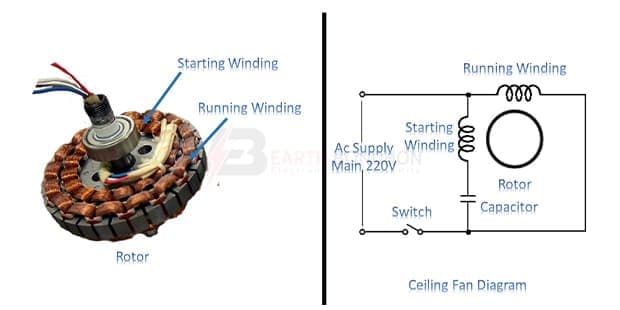Fan and Capacitor Connection:
This diagram shows how to connect the fan and capacitor connection. We need a ceiling fan, capacitor, and switch in this circuit. We know A capacitor is basically an electric charge storage device or an electrical passive device that can store charge. Its Bengali meaning is “container” which means that holds an electric charge. We know that a ceiling fan needs starting capacitor. Without a capacitor, the fan can not be run. In this diagram, we just describe how to connect the ceiling fan capacitor. If you want to see our youtube video please check out the below youtube video and know more about this diagram.
Advertisements
Components needed For this Project:
You can get the components from any of the sites below:
*Please note: These are affiliate links. I may make a commission if you buy the components through these links. I would appreciate your support in this way!
Advertisements
Components used to make the Fan and Capacitor connection:
A Ceiling Fan is a fan Mounted on the Ceiling of a Room or space, Usually, Electrically Powered, That Uses hub-mounted Rotating Blades to Circulate air flow. They cool people effectively by increasing speed. It Doesn not Cool the Air Temperature — we Feel Cooler Because the Fan Moves the Air Around Us, a Process Called Evaporative Cooling. Evaporative Cooling Works like this: A cold day will feel Even Cooler if There is a Breeze Because of the wind Chill Factor.
02. Capacitor:
This 2.5 MFD Capacitor Electric motor Capacitor article Series Explains the Selection, Testing, installation, & use of Electric Motor Starter Start and run Capacitors used on Various Electric Motors Found in or at Buildings such as air Conditioner Compressors, fan Motors, and some Good Pumps. An Electric motor is run Capacitor (2.5 MFD Capacitor) Remains active after the Starting cap has Dropped from the circuit (as the motor has its proper speed), and 2.5 MFD Capacitor indeed the value of the run Capacitor can affect Motor Speed.
Thank You for visiting the website. Keep visiting for more Updates.
Frequently asked questions
Generally, in the ceiling fan, there are 2 windings running winding & starting and winding. A capacitor must be connected to the starting and winding in series after that, it must be connected across the power supply. Alternatively, the running and winding are directly connected to the power supply.
The speed can be controlled in two ways - controlling the voltage to the adjust lead or controlling the resistance between the adjust lead and the return. Either pulse width modulation or a variable voltage/resistance can be accomplished by either method.
Fan speed is controlled with thyristor or transformer speed project system controllers. Thyristor speed control. Thyristor speed controllers provide smooth manual motor speed control and airflow control respectively. Operation of the thyristor speed and controllers is based on output voltage control with a triac voltage and regulator.
A Fan Regulator, as the name suggests, regulates or controls the is the speed of the fan motor. Before dealing with the fan regulator, a brief discussion about the circuit diagram fan motor is necessary, as the main power supply purpose of the regulator is to control the speed of the fan motor.
Phase Angle-Controlled and Regulator: Commonly known as Dimmer Switches, they employ semiconductor devices to adjust the voltage across the fan. Compared to resistive regulators, they are more efficient due to lower power supply consumption. However, there can be continuous of speed control but lacks linear Speed control.
Read more Single Phase Wiring
What is a kilowatt-hour (kWh) | kwh formula | What does kwh mean
Introduction to Electrical Units and CircuitskW and kWh on your electricity bill As your home uses electricity during...
What is the Difference Between kVA | What does KVA mean | kVA formula
Difference Between KVA ExplainedWhat does KVA Mean? There are technical terms aplenty when it comes to generators, and...
Power Factor | Power Unit | Energy | Electricity Unit
Power factor definition | Calculating Power FactorPower Factor Values In a purely resistive circuit, the power factor...



0 Comments
Trackbacks/Pingbacks